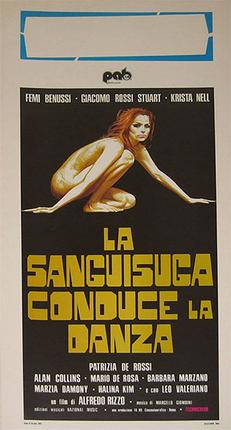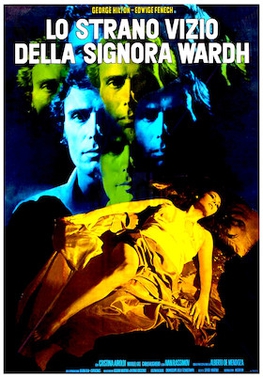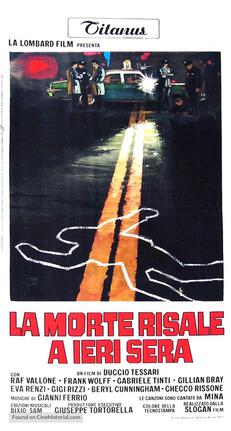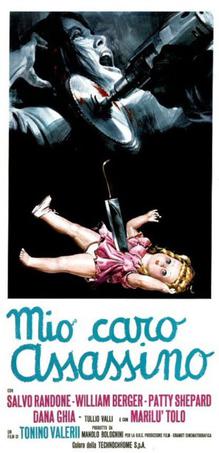
Lucio Fulci was an Italian film director, screenwriter, and actor. Although he worked in a wide array of genres through a career spanning nearly five decades, including comedies and spaghetti Westerns, he garnered an international cult following for his giallo and horror films.

In Italian cinema, giallo is a genre of murder mystery fiction that often contains slasher, thriller, psychological horror, psychological thriller, sexploitation, and, less frequently, supernatural horror elements.

Lamberto Bava is an Italian film director. Born in Rome, Bava began working as an assistant director for his director father Mario Bava. Lamberto co-directed the 1979 television film La Venere d'Ille with his father and in 1980 directed his first solo feature film Macabre.

The New York Ripper is a 1982 Italian giallo film directed by Lucio Fulci, and co-written by Gianfranco Clerici, Vincenzo Mannino, and Dardano Sacchetti. The film is about a police lieutenant who is tracking a sadistic killer who slashes women with a switchblade and straight-razors.

Edwige Fenech is a French-Italian actress and film producer. She is mostly known as the star of a series of commedia sexy all'italiana and giallo films released in the 1970s, which turned her into a sex symbol.
Sergio Martino is an Italian film director and producer, notable for his contributions to the giallo genre.
Ernesto Gastaldi is an Italian screenwriter. Film historian and critic Tim Lucas described Gastaldi as the first Italian screenwriter to specialize in horror and thriller films. Gastaldi worked within several popular genres including pepla, Western and spy films.

Umberto Lenzi was an Italian film director, screenwriter, and novelist.

Phantom of Death is a 1988 Italian giallo film directed by Ruggero Deodato. It starred Michael York, Donald Pleasence and Edwige Fenech.

The Bloodsucker Leads the Dance is a 1975 Italian film directed by Alfredo Rizzo.

The Strange Vice of Mrs. Wardh is a 1971 giallo mystery film directed by Sergio Martino, and starring Edwige Fenech, George Hilton, Ivan Rassimov, and Alberto de Mendoza. Its plot follows the wife of a diplomat who finds herself being stalked by her former abusive lover in Vienna.

L'iguana dalla lingua di fuoco is a 1971 giallo film. It is directed by Riccardo Freda, who was unhappy with the film and had his name replaced with the pseudonym "Willy Pareto".

Il coltello di ghiaccio is a 1972 giallo film directed by Umberto Lenzi and starring Carroll Baker, Evelyn Stewart, and George Rigaud. Both Baker and Stewart featured in several other films helmed by Lenzi. The film follows a mute woman who finds herself in danger when a serial killer begins stalking the Spanish countryside. The title takes its name from a quote attributed to Edgar Allan Poe, in which he refers to fear as a "knife of ice which penetrates the senses down to the depth of conscience"; the quote, however, was a fabrication by the filmmakers.

Omicidio per appuntamento is a 1966 giallo film directed by Mino Guerrini. The film stars George Ardisson, Günther Stoll and Ella Karin. Adapted from a novel by Franco Enna, the film has been described as "stylish" and "flamboyant", and has been seen as inspired by the work of Mario Bava.

La morte risale a ieri sera is a 1970 crime film directed by Duccio Tessari. The film was written by Tessari and Biagio Proietti and based on the novel I milanesi ammazzano al sabato by Giorgio Scerbanenco.

The Case of the Bloody Iris is a 1972 Italian giallo film directed by Giuliano Carnimeo, identified in the credits as Anthony Ascott. The film was referred to as "never boring" and "a competent thriller which offers enough violence and sex to satisfy the most ardent giallo fan".
Luciano Martino was an Italian film producer, director and screenwriter.

My Dear Killer is a 1972 Italian-Spanish giallo film directed by Tonino Valerii and starring George Hilton, Marilù Tolo, Patty Shepard, Helga Line, Salvo Randone and William Berger. Some critics considered it "one of the best films in the thriller genre" and as "one of the best, most vibrant and well designed products of Italian giallo."

La Casa del Buon Ritorno is a 1986 Italian giallo written and directed by Beppe Cino. It is also known as The House of the Blue Shadows. The film was theatrically released in Germany as Das Haus der Blauen Schatten.
















